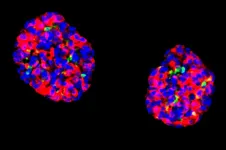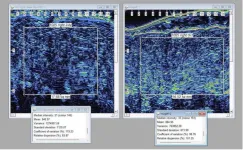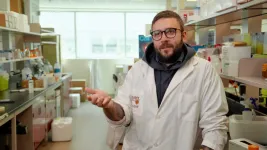(Press-News.org) Images // Video
Cage structures made with nanoparticles could be a route toward making organized nanostructures with mixed materials, and researchers at the University of Michigan have shown how to achieve this through computer simulations.
The finding could open new avenues for photonic materials that manipulate light in ways that natural crystals can't. It also showcased an unusual effect that the team is calling entropy compartmentalization.
"We are developing new ways to structure matter across scales, discovering the possibilities and what forces we can use," said Sharon Glotzer, the Anthony C. Lembke Department Chair of Chemical Engineering, who led the study published today in Nature Chemistry. "Entropic forces can stabilize even more complex crystals than we thought."
While entropy is often explained as disorder in a system, it more accurately reflects the system's tendency to maximize its possible states. Often, this ends up as disorder in the colloquial sense. Oxygen molecules don't huddle together in a corner—they spread out to fill a room. But if you put them in the right size box, they will naturally order themselves into a recognizable structure.
Nanoparticles do the same thing. Previously, Glotzer's team had shown that bipyramid particles—like two short, three-sided pyramids stuck together at their bases— will form structures resembling that of fire ice if you put them into a sufficiently small box. Fire ice is made of water molecules that form cages around methane, and it can burn and melt at the same time. This substance is found in abundance under the ocean floor and is an example of a clathrate. Clathrate structures are under investigation for a range of applications, such as trapping and removing carbon dioxide from the atmosphere.
Unlike water clathrates, earlier nanoparticle clathrate structures had no gaps to fill with other materials that might provide new and interesting possibilities for altering the structure's properties. The team wanted to change that.
"This time, we investigated what happens if we change the shape of the particle. We reasoned that if we truncate the particle a little, it would create space in the cage made by the bipyramid particles," said Sangmin Lee, a recent doctoral graduate in chemical engineering and first author of the paper.
He took the three central corners off each bipyramid and discovered the sweet spot where spaces appeared in the structure but the sides of the pyramids were still intact enough that they didn't start organizing in a different way. The spaces filled in with more truncated bipyramids when they were the only particle in the system. When a second shape was added, that shape became the trapped guest particle.
Glotzer has ideas for how to create selectively sticky sides that would enable different materials to act as cage and guest particles, but in this case, there was no glue holding the bipyramids together. Instead, the structure was completely stabilized by entropy.
"What's really fascinating, looking at the simulations, is that the host network is almost frozen. The host particles move, but they all move together like a single, rigid object, which is exactly what happens with water clathrates," Glotzer said. "But the guest particles are spinning around like crazy—like the system dumped all the entropy into the guest particles."
This was the system with the most degrees of freedom that the truncated bipyramids could build in a limited space, but nearly all the freedom belonged to the guest particles. Methane in water clathrates rotates too, the researchers say. What's more, when they removed the guest particles, the structure threw bipyramids that had been part of the networked cage structure into the cage interiors—it was more important to have spinning particles available to maximize the entropy than to have complete cages.
"Entropy compartmentalization. Isn't that cool? I bet that happens in other systems too—not just clathrates," Glotzer said.
Thi Vo, a former postdoctoral researcher in chemical engineering at U-M and now an assistant professor of chemical and biomolecular engineering at the Johns Hopkins University, contributed to the study.
This study was funded by the Department of Energy and Office of Naval Research, with computing resources provided by the National Science Foundation's Extreme Science and Engineering Discovery Environment and the University of Michigan.
Glotzer is also the John Werner Cahn Distinguished University Professor of Engineering, the Stuart W. Churchill Collegiate Professor of Chemical Engineering, and a professor of materials science and engineering, macromolecular science and engineering, and physics.
Study: Entropy compartmentalization stabilizes open host–guest colloidal
Clathrates. (DOI: 10.1038/s41557-023-01200-6)
END
Making the structure of 'fire ice' with nanoparticles
The structure harnesses a strange physical phenomenon and could enable engineers to manipulate light in new ways.
2023-05-25
ELSE PRESS RELEASES FROM THIS DATE:
Large study provides scientists with deeper insight into long COVID symptoms
2023-05-25
Large study provides scientists with deeper insight into long COVID symptoms
NIH-funded research effort identifies most common symptoms, potential subgroups, and initial symptom-based scoring system – with aim of improving future diagnostics and treatment
Initial findings from a study of nearly 10,000 Americans, many of whom had COVID-19, have uncovered new details about long COVID, the post-infection set of conditions that can affect nearly every tissue and organ in the body. Clinical symptoms can vary and include fatigue, brain fog, and dizziness, and last for months or years after ...
Intravenous plus periarticular corticosteroids improve rehabilitation measures after knee replacement
2023-05-25
May 25, 2023 – For patients undergoing total knee arthroplasty (TKA), a combination of intravenous and periarticular corticosteroids does not improve pain control – but, may improve key indicators of functional recovery in the days after surgery, reports a trial in The Journal of Bone & Joint Surgery. The journal is published in the Lippincott portfolio in partnership with Wolters Kluwer.
Intravenous (IV) plus periarticular (PA) steroids "yielded more significant improvements in the rehabilitation parameters," ...
Microneedling plus cupping may aid skin rejuvenation
2023-05-25
May 25, 2023 – A combination of emerging and alternative techniques – microneedling to induce collagen and cupping to increase tissue perfusion – may have a synergistic effect in producing skin rejuvenation, according to an experimental study in the June issue of Plastic and Reconstructive Surgery®, the official medical journal of the American Society of Plastic Surgeons (ASPS). The journal is published in the Lippincott portfolio by Wolters Kluwer.
"Cupping therapy can be added to microneedling therapy and used to increase certain desired effects on skin," comments lead author Burak Pasinlioğlu, MD, of Kecioren Research ...
Scientists target human stomach cells for diabetes therapy
2023-05-25
Stem cells from the human stomach can be converted into cells that secrete insulin in response to rising blood sugar levels, offering a promising approach to treating diabetes, according to a preclinical study from researchers at Weill Cornell Medicine.
In the study, which appeared April 27 in Nature Cell Biology, the researchers showed that they could take stem cells obtained from human stomach tissue and reprogram them directly—with strikingly high efficiency—into cells that closely resemble pancreatic insulin-secreting cells known as beta cells. Transplants of small groups of these cells reversed disease signs in a mouse model of diabetes.
“This ...
Sage’s 10-Year Impact Awards recognize research with long-term influence
2023-05-25
For the fourth year, Sage has awarded 10-Year Impact Awards to three research articles that have had a lasting influence over the past decade. The awards are given to the authors of three papers published in Sage Journals in 2012 that have received the most citations in the 10 years since than all other studies published in the same year.
The three winning papers are:
“The Nature and Organization of Individual Differences in Executive Functions: Four General Conclusions” by Akira Miyake and Naomi P. Friedman in Current Directions ...
CU researchers weave deeper understanding of diverse ancestry and gene expression
2023-05-25
Exploring diverse ancestry is a critical factor in furthering medical research.
A new study published in Nature Genetics from researchers in the Department of Biomedical Informatics (DBMI) at the University of Colorado School of Medicine, in partnership with the University of California San Francisco and Stanford University, is the largest of its kind that focuses on ancestry correlations with biomedical traits and the first study to examine the role of genetic variants across diverse ...
Does body contouring increase long-term weight loss after bariatric surgery? New findings
2023-05-25
May 25, 2023 – For patients with massive weight loss after bariatric surgery, subsequent body contouring to remove excess skin is not itself associated with long-term weight loss, reports a study in the June issue of Plastic and Reconstructive Surgery®, the official medical journal of the American Society of Plastic Surgeons (ASPS). The journal is published in the Lippincott portfolio by Wolters Kluwer.
"In contrast to previous studies, we found that body contouring ...
Epigenetic mechanisms activated by GHK-Cu increase skin collagen density in clinical trial
2023-05-25
Skin loses collagen and elastin and becomes progressively thinner with age leading to wrinkles, so reversing this age-related loss of skin density is the holy grail of anti-aging treatments. One compound capable of doing that is the naturally occurring peptide GHK-Cu (GHK from glycyl-L-histidyl-L-lysine bound to a copper ion), which affects 31.2% of the human genes by either activating or deactivating them (based on a criterion of a reduction or increment in gene activity of more than 50%), meaning that it works by ...
Scientists use AI to find promising new antibiotic to fight evasive hospital superbug
2023-05-25
Attention editors: Embargoed by the journal Nature Chemical Biology until Thursday, May 25 at 11 a.m. easter
Hamilton, ON, May 25, 2023 – Scientists at McMaster University and the Massachusetts Institute of Technology have used artificial intelligence to discover a new antibiotic which could be used to fight a deadly, drug-resistant pathogen that strikes vulnerable hospital patients.
The process they used could also speed the discovery of other antibiotics to treat many other challenging ...
A metabolic process in cancer cells could unlock a possible treatment for glioblastoma
2023-05-25
A study led by researchers at the UCLA Jonsson Comprehensive Cancer Center has found that targeting a metabolic process in people with a specific genetic mutation could help treat glioblastoma, an aggressive brain cancer.
The genetic alteration — a deletion in a gene called CDKN2A — is present in about 60% of people who have glioblastoma. The mutation causes changes in the way lipids are distributed in cancer cells, which in turn makes the cancer cells vulnerable to being destroyed. The ...
LAST 30 PRESS RELEASES:
The Lancet: COVID-19 vaccine hesitancy decreased over time, though mistrust persists among certain groups, study of over 1 million people in England suggests
Psychosis patients ‘living in metaphor’ -- new study radically shifts ideas about delusions
Clinical trial in Ethiopia targets the trachoma scourge
Open-sourcing the future of food
Changes in genetic structure of yeast lead to disease-causing genomic instabilities
UC San Diego Health Sciences Grant Writing Course helps launch successful research careers
Study: Many head and neck cancer trials end early. Why?
Tufts vice provost for research named Foreign Fellow of Indian National Science Academy
New model improves prediction of prostate cancer death risk
Two wrongs make a right: how two damaging variants can restore health
Overlooked decline in grazing livestock brings risks and opportunities
Using rare sugars to address alcoholism
Research alert: New vulnerability identified in aggressive breast cancer
Ruth Harris honored with SSA Distinguished Service Award
Treasure trove of data on aging publicly accessible
Trees4Adapt project to address risks from climate change and biodiversity loss through tree-based solutions
Nature Communications study from the Lundquist Institute identifies molecular mechanism underlying peripartum cardiomyopathy
Pennington Biomedical’s Dr. Gang Hu appointed to NIH Reproductive, Perinatal and Pediatric Health Review Group
World-first project shows great promise to treat low eye pressure
New technique puts rendered fabric in the best light
Brain cancer digital twin predicts treatment outcomes
Cat disease challenges what scientists thought about coronaviruses
Paulson Family Foundation makes an additional $19 million donation to Hebrew University to fund a new building for electrical engineering. Together with its previous gift brings the total donation to
Canada–Estonia partnership advances community-centered clean energy
Sandia’s economic impact sets record for 17th consecutive year
Researchers uncover how tumors become resistant to promising p53-targeted therapy
Aligning games and sets in determining tennis matches
UOC research team develops method to evaluate apps for treating depression
Extreme heat waves disrupt honey bee thermoregulation and threaten colony survival
New brain study explains how binge drinking contributes to long-lasting negative feelings
[Press-News.org] Making the structure of 'fire ice' with nanoparticlesThe structure harnesses a strange physical phenomenon and could enable engineers to manipulate light in new ways.


